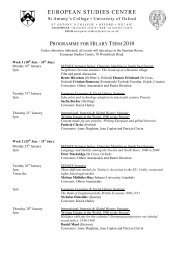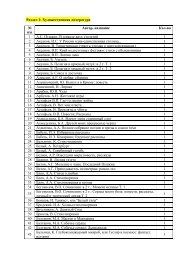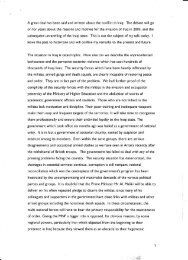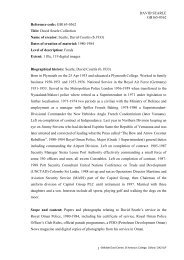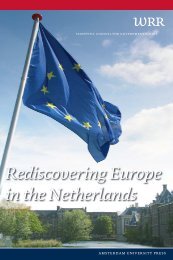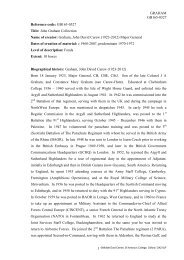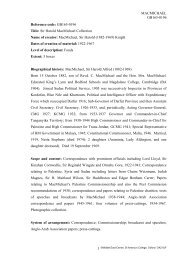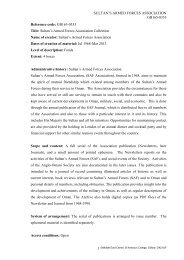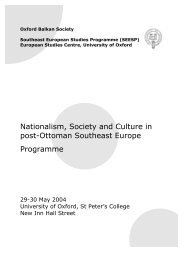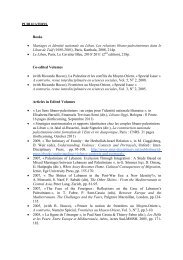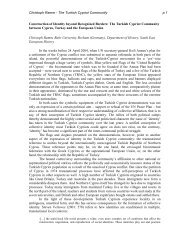Managing Migration: The Global Challenge, Population Bulletin, Vol ...
Managing Migration: The Global Challenge, Population Bulletin, Vol ...
Managing Migration: The Global Challenge, Population Bulletin, Vol ...
Create successful ePaper yourself
Turn your PDF publications into a flip-book with our unique Google optimized e-Paper software.
<strong>Managing</strong> <strong>Migration</strong>: <strong>The</strong> <strong>Global</strong> <strong>Challenge</strong><br />
Table 3<br />
Foreigners and Foreign Workers in Western Europe, 2005<br />
Foreign<br />
population<br />
(thousands)<br />
Percent<br />
of total<br />
population<br />
Foreign<br />
labor force<br />
(thousands)<br />
Percent of<br />
total labor<br />
force<br />
Austria 802 10 418 12<br />
Belgium 901 9 435 9<br />
Denmark 270 5 109 4<br />
France 3,263 6 1,456 5<br />
Germany 6,756 9 3,823 9<br />
Ireland 259 6 102 6<br />
Italy 2,671 5 1,479 6<br />
Luxembourg 181 40 196 63<br />
Netherlands 691 4 288 3<br />
Norway 222 5 159 7<br />
Spain 2,739 6 1,689 8<br />
Sweden 480 5 216 5<br />
Switzerland 1,512 20 830 21<br />
United Kingdom 3,035 5 1,504 5<br />
Note: Data for foreign population in France are for 1999. Data for foreign labor force in Ireland,<br />
2002; Italy, 2003; and Sweden, 2004.<br />
Source: Organisation for Economic Co-operation and Development, International <strong>Migration</strong><br />
Outlook (2007): tables A.15 and A2.3.<br />
follow a common set of rules for checks at borders<br />
between EU and non-EU states. <strong>The</strong> treaty effectively<br />
expanded the free-travel zone established between the<br />
Benelux Economic Union (Netherlands, Belgium,<br />
Luxembourg), Germany, France, Italy, Spain, Portugal,<br />
Greece, Austria, Denmark, Finland, and Sweden,<br />
under the 1985 Schengen Agreement and the 1990<br />
Schengen Convention. <strong>The</strong> agreement led to a common<br />
system for issuing visas and a database that<br />
includes information on people that the EU member<br />
countries want to exclude. 29 Ireland and the United<br />
Kingdom, already EU members in 1999 and not signatories<br />
of the Schengen agreements, still enforce border<br />
controls with other EU member states.<br />
Germany had the most foreign residents of any EU<br />
member in 2005, some 6.8 million, followed by France<br />
with 3.3 million (in 1999), the UK with 3 million, and<br />
Italy and Spain with 2.7 million each (see Table 3). Luxembourg<br />
had the highest percentage of foreigners among<br />
residents—40 percent—followed by Switzerland with 20<br />
percent and Austria with 10 percent.<br />
<strong>The</strong> European population is aging and shrinking. <strong>The</strong><br />
EU today has four workers for each retiree. By 2050, the<br />
ratio is projected to be two workers per retiree. In order<br />
to finance the retirement of such a large cohort of retirees,<br />
EU countries will have to reduce pension benefits or<br />
encourage more people to work longer. Other alternatives<br />
are to increase the number of workers, either by increasing<br />
fertility or immigration. Most European countries<br />
make payments to families with children, and these policies<br />
are credited with keeping fertility near replacement<br />
level (2.1 children per woman, on average) in France and<br />
Scandinavia. Other European countries are increasing<br />
child payments in a bid to boost fertility.<br />
Immigration would have to be very high to stave off<br />
population decline in countries such as Italy (see Table 4).<br />
<strong>The</strong> UN <strong>Population</strong> Division estimated the number of<br />
immigrants that various countries would have to admit to<br />
maintain their 1995 populations, labor forces, and ratios<br />
of younger to older persons.<br />
<strong>The</strong> Big Four EU countries (France, Germany, Italy,<br />
and the UK) received about 88 percent of the EU’s immigrants<br />
in 1995. To maintain their 1995 populations at<br />
current fertility rates, immigration would have to triple,<br />
from 237,000 a year to 677,000 a year; immigration to<br />
Italy would have to increase over 42 times its mid-1990s<br />
level. To maintain their 1995 labor forces, the Big Four<br />
would have to increase immigration to 1.1 million a year,<br />
and to “save social security” or maintain the ratio of persons<br />
18 to 64 years old to persons 65 and older, immigration<br />
would have to increase 37-fold, to almost 9 million a<br />
year, including 2.3 million a year to Italy.<br />
Opinion polls suggest that most Europeans do not welcome<br />
more immigration. 30 EU nations currently receive<br />
300,000 to 500,000 legal newcomers a year, including<br />
returning citizens, family members of settled foreigners,<br />
guest workers, and asylum applicants. In addition, up to<br />
500,000 unauthorized foreigners enter the EU annually,<br />
though not all remain as residents. Any suggestion to increase<br />
current immigration flows or legalize unauthorized<br />
foreigners tends to produce strong political opposition<br />
from EU nationals. 31<br />
Opposition to immigration and legalization of unauthorized<br />
immigrants is also strong in Russia, the most<br />
populous European country with 142 million residents.<br />
Although the population in Russia is shrinking by about<br />
700,000 a year, most Russians do not welcome immigration<br />
as a way to stop the decrease. Ease of movement<br />
among the Commonwealth of Independent States (CIS)<br />
that were part of the Soviet Union. and higher wages in<br />
Russia draw migrants from CIS to Russia. Workers from<br />
Moldova and Tajikistan earn up to 10 times more in construction<br />
and service jobs in Moscow and other Russian<br />
cities than they would at home. Responses to this migration<br />
stream have included both anti-migrant movements<br />
and efforts to legalize migrants.<br />
Asia<br />
Asia, home to 60 percent of the world’s people, is a major<br />
source of immigrants for countries in North America.<br />
People also migrate within Asia, usually as guest workers<br />
expected to leave after two years. Thai workers migrate<br />
to Taiwan to fill construction jobs, for example, and<br />
12 www.prb.org <strong>Population</strong> <strong>Bulletin</strong> <strong>Vol</strong>. 63, No. 1 2008



